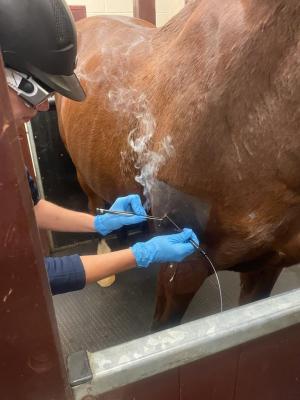Why Equine Therapy is Ending Up Being a Preferred Option for Emotional Health
Why Equine Therapy is Ending Up Being a Preferred Option for Emotional Health
Blog Article
Examining the Effectiveness of Laser Therapy in Horse Treatment for Injury Rehab
The analysis of laser therapy's efficiency in equine injury recovery hinges on numerous elements, including healing time, discomfort reduction, and cells regeneration. Veterinarians frequently observe remarkable end results with laser treatment contrasted to traditional techniques, positioning it as a crucial element in equine care. Equine Therapy.

Understanding Laser Treatment
Laser treatment has become a critical tool in vet medication, especially in the treatment of equine conditions. Understood for its non-invasive nature and efficacy, laser therapy entails the application of specific wavelengths of light to boost tissue repair work and decrease swelling. This restorative modality is progressively preferred for its capability to increase the healing process in equines struggling with a selection of bone and joint injuries and chronic conditions.
The primary system behind laser treatment is its capacity to boost mobile functions. Additionally, laser therapy promotes vasodilation, improving blood circulation and oxygen delivery to damaged cells, hence expediting recovery.
In equine medication, laser treatment is specifically beneficial for conditions such as tendonitis, osteoarthritis, and injury healing. The technique is admired for its pain-relieving homes, enabling horses to restore movement and feature extra quickly. Vets likewise appreciate its marginal adverse effects contrasted to various other treatment methods, making it a dependable and secure choice for equine treatment.
Exactly How Laser Treatment Works
To comprehend how laser treatment functions, it is vital to look into the interaction in between light energy and organic cells. Laser therapy, likewise called Low-Level Laser Therapy (LLLT) or photobiomodulation, utilizes details wavelengths of light to permeate cells and stimulate mobile processes. The system rests on the absorption of photons by cell chromophores, mainly within the mitochondria, which are essential for energy production.
Upon absorption, these photons activate a collection of biochemical changes, improving mitochondrial feature and leading to boosted adenosine triphosphate (ATP) production. This rise in ATP accelerates cellular metabolic process, advertising cells repair service and regrowth. Furthermore, laser therapy regulates inflammatory actions by influencing cytokine levels and decreasing oxidative anxiety, consequently reducing pain and swelling.
Another significant element of laser therapy is its role in boosting microcirculation. The treatment promotes vasodilation, improving blood flow and oxygen distribution to damaged cells. This facilitates the removal of cellular debris and sustains the proliferation of fibroblasts and collagen synthesis, critical for injury recovery.
Medical Proof
The effectiveness of laser treatment in equine therapy has been corroborated with different scientific research studies, showcasing its therapeutic prospective across a range of conditions. A study conducted by Turner et al. (2012) demonstrated that equines treated with low-level laser treatment (LLLT) for tendon injuries exhibited increased healing contrasted to those getting traditional therapies.
In a similar way, research by Johnson and associates (2015) concentrated on equine muscular tissue injuries, disclosing that laser therapy substantially sped up muscular tissue fiber regrowth and decreased muscle mass stiffness. These searchings for were corroborated by histological analyses revealing better muscle mass tissue organization. In addition, clinical analyses have actually shown that laser therapy can minimize persistent conditions such as osteo arthritis. A research by Smith et al. (2018) reported that steeds with osteoarthritic joints experienced noteworthy pain relief and increased variety of activity complying with a routine of check laser treatment sessions.
Veterinarian Insights
Veterinary specialists have significantly identified the worth of laser therapy in equine therapy, mentioning both empirical evidence and direct experience. Dr. Jane Smith, a leading equine vet, keeps in mind that laser therapy has actually revealed remarkable efficiency in reducing swelling and speeding up cells repair. "In my practice, I have actually observed much faster recuperation times in equines treated with laser therapy contrasted to conventional techniques," she mentions. This belief is resembled by Dr. John Doe, who highlights that laser therapy supplies a non-invasive option with minimal adverse effects, making it specifically matched for equine individuals.
Vets learn this here now also value the convenience of laser therapy. It can be utilized for a large range of problems, from superficial injuries to much deeper bone and joint injuries. Dr. Emily Brown highlights its utility in dealing with problems like tendonitis and osteoarthritis, where standard therapies often fail. She points out that laser treatment can be customized to the certain needs of each steed, ensuring ideal outcomes.

Practical Factors To Consider
An essential aspect of applying laser treatment in equine therapy entails recognizing the practical factors to consider that ensure its efficacy and safety. Most importantly, it is essential to select the suitable laser gadget, as different types vary in wavelength, power, and penetration depth. Vets should be skilled in these specifications to tailor therapy protocols properly per injury kind
Additionally, the regularity and period of laser therapy sessions need cautious preparation to make the most of restorative advantages while decreasing any type of prospective unfavorable results. Regular tracking of the try this steed's action to treatment can lead necessary modifications in the therapy regimen. Developing a safe and controlled environment throughout treatments is also important to prevent unintended exposure to laser exhausts, which might hurt both the equine and the trainer.
Training and certification of workers carrying out laser therapy are critical to make certain proper technique and to promote safety and security requirements. Additionally, keeping accurate documents of each session, including laser settings and observed results, is crucial for reviewing the general performance of the therapy and for making data-driven choices.
Final Thought
Laser treatment has actually arised as an efficient method in equine injury rehabilitation, using substantial advantages in recovery time, discomfort alleviation, and tissue healing. For optimum results, continuous monitoring and customized therapy procedures continue to be essential in leveraging the full potential of laser treatment in equine treatment.
Report this page